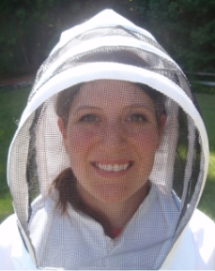I was looking at my hive yesterday and saw a sad sight. A few bees were convulsing on the doorstep of the hive. Their legs were twitching and their proboscises were sticking out (like you’d see a tongue loll out of someone’s mouth when they were having a seizure). It was very sad to watch. My latest theory is that some of my girls were hit with a dose of neuro-poison pesticide. I recently discovered that our town is part of the “Central Massachusetts Mosquito Control Project” or CMMCP. This means that at will the CMMCP can spray pesticides anywhere on your property to stop mosquito activities. According to their schedule they spray each town weekly with these chemicals, and urge individuals to stay indoors after sundown when they are spraying. If you are adverse to the idea of spraying pesticides you can put your property on the “no spray” list. Unfortunately this means that even if you’re on the “no spray” list, and your neighbor is pesticide happy and calls CMMCP weekly, the pesticides could still drift onto your property or your bees could forage in your neighbors yard during the spraying and promptly die.
I may sound like a bit of a libertarian, but my first thought was, ‘pesticides are toxic, not only to insects, but generally to mammals as well – do they really need to spray weekly or at all’? The worst part is that I wouldn’t have even known about the pesticide spraying had our neighbors not mentioned it to us. You would have expected a flier or something in the mail to warn residents not to venture outside during certain hours. To be fair, the spray information is displayed prominently on the town website during the summer – but really, how often do residents go to the town website?
Knowing I was a beekeeper, my neighbor was kind enough to obtain the datasheets for the chemicals they are spraying. Anvil 10+10 ULV (d-Phenothrin/Sumithrin) is pretty nasty stuff. While it is affective on mosquitos it is listed as “highly toxic to bees” as well as aquatic organisms. In the datasheet they also mention it is harmful to humans if it absorbed through the skin (do not be outside during application). On the internet there are studies showing it has been known to cause liver tumors in mammals. In addition it was taken off the market as a flea/tick preventative because it was poisoning dogs and cats. Though the poison is dangerous, it is used to kill mosquitos and prevent the propagation of West Nile Virus (WNV) and Eastern equine encephalitis (EEE), both of which can lead to death or brain damage in a small percentage of the population.
So, with these terrifying outcomes, how worried should I be about these mosquito diseases? For perspective 270 people in America died from West Nile Virus last year. Over the last 50 years approximately 6 people a year have contracted EEE (most of the EEE cases are in the New England area). Assuming that everyone in the US is at an equal risk for contracting and dying of WNV there is a less than .0001% chance that you will die from WNV. And assuming that only New England is susceptible to EEE there is less than .000001% chance you will contract EEE. These two figures hover right around the likelihood that you will be struck by lightning. So what do you believe? Is it worth destroying the natural environment and exposing yourself to carcinogens to further reduce this figure?


Denver has a program where they drive by once a week with a lightning rod. I haven’t opted out.